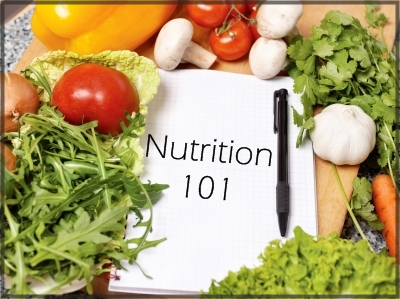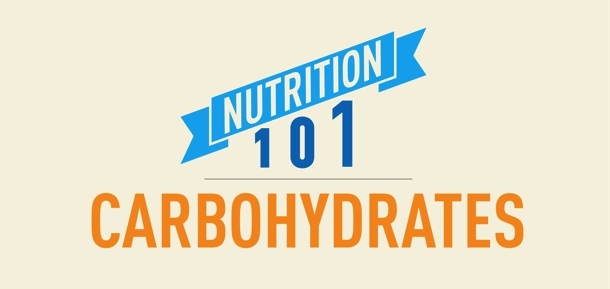 Continuing with our Nutrition 101 series, today we’re talking carbohydrates!
Continuing with our Nutrition 101 series, today we’re talking carbohydrates!
Carbohydrates or Carbs. as they are more commonly referred to these days, (couldn’t resist the misspelling) have undoubtedly gotten a bad wrap over recent years but whether you love them or not–they’re in everything–and we can certainly benefit from choosing the more nutrient-dense kinds.
 Carbohydrates are found in pretty much everything – From the very good for you fruits and vegetables, grains, nuts and seeds and dairy, to the not so good for you sweets, soda, the list goes on.
Carbohydrates are found in pretty much everything – From the very good for you fruits and vegetables, grains, nuts and seeds and dairy, to the not so good for you sweets, soda, the list goes on.
When it comes to choosing carbohydrates to eat or drink, nutrient-dense sources are definitely the way to go.
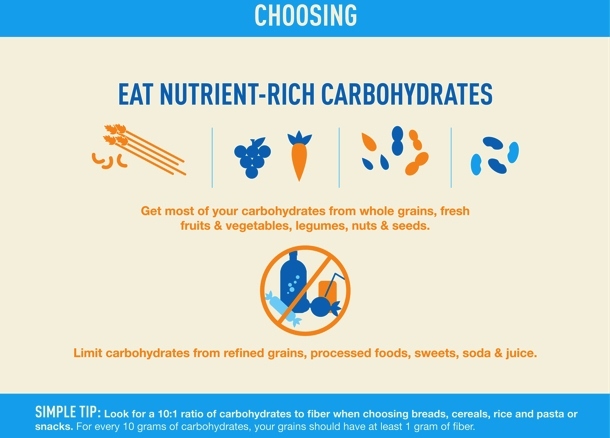 These include complex carbs like 100% whole grain breads and pasta, brown rice, starchy vegetables (just leave the nutrient-rich skins on those potatoes), legumes, nuts, seeds, low-fat dairy and plenty of fruits and vegetables. We want to maximize nutrition density and satiety from carbohydrates, so limiting simple sugars from refined grains, processed snack foods, sweets, and sugar-sweetened beverages is best.
These include complex carbs like 100% whole grain breads and pasta, brown rice, starchy vegetables (just leave the nutrient-rich skins on those potatoes), legumes, nuts, seeds, low-fat dairy and plenty of fruits and vegetables. We want to maximize nutrition density and satiety from carbohydrates, so limiting simple sugars from refined grains, processed snack foods, sweets, and sugar-sweetened beverages is best.
You have probably heard of carbohydrates described as either “good” or “bad” for you. This is a very simplified way of describing this micronutrient. Carbohydrates provide your body with its basic fuel. Your body thinks about carbohydrates like a car engine thinks about gasoline. But like your car not every fuel is right for your engine. If your car is going to be racing you would need a special kind of fuel to perform more efficiently for the kind of action it will be performing then say your daily driving needs. This is the same for Carbohydrates. Carbohydrates are your bodies main fuel source, sometimes you need the racing fuel and sometimes you just need to get from point A to point B making them neither good or bad. To get a better idea of which carbohydrates to choose for optimum health we first must talk carbohydrate metabolism, how our body breaks them down and uses them.
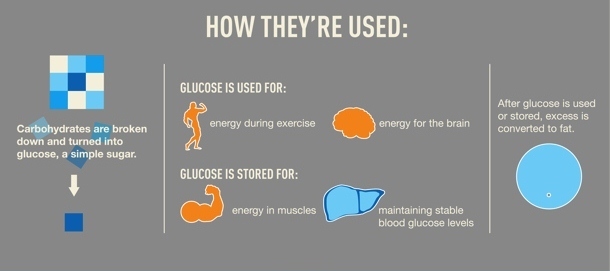 Carbohydrate Metabolism
Carbohydrate Metabolism
The word “carbohydrate” comes from the fact that glucose is made up of carbon and water.
After eating a meal, carbohydrates are separated from dietary fiber and broken down into three monosaccharides: glucose, fructose and galactose. Glucose is a simple sugar, meaning that to our tongues it tastes sweet. There are other simple sugars that you have probably heard of. Fructose is the main sugar in fruits. Fructose has the same chemical formula as glucose (C6H12O6), but the atoms are arranged slightly differently. The liver converts fructose to glucose. Sucrose, also known as “white sugar” or “table sugar,” is made of one glucose and one fructose molecule bonded together. These monosaccharides are absorbed in the small intestine and enter the the blood stream. Much like a car that runs on unleaded fuel, our cells only take up carbohydrates in the form of glucose, so the liver then converts all of the fructose and galactose into glucose.
Glucose is transported through the blood stream and is:
- Immediately taken up by cells and turned into energy
- Stored as glycogen by the liver and skeletal muscles (Glycogen in muscles is turned back into glucose for energy during exercise and liver glycogen is what maintains our blood glucose levels during short fasting periods, like while we sleep.)
- Converted into fatty acids and triglycerides for long-term energy storage, if consumed in excess
They may all be broken down and turned into glucose, but all carbohydrates are not created equal. Some are more nutritionally dense than others; different types are digested at different rates and have different impacts on our blood sugar.
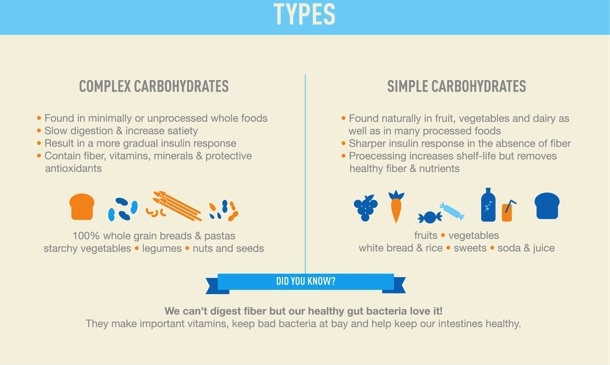 So lets compare the two main types, complex and simple carbohydrates:
So lets compare the two main types, complex and simple carbohydrates:
Complex carbohydrates are largely found in whole grains, starchy vegetables, legumes, nuts and seeds. They are mainly starches and fibers. A complex carbohydrate is made up of chains of glucose molecules. Starches are the way plants store energy — plants produce glucose and chain the glucose molecules together to form starch. Most grains (wheat, corn, oats and rice) and things like potatoes and plantains are high in starch.
What makes them complex, you ask?
To a great extent it has to do with the processes of digestion and absorption. They contain longer, more complex chains of sugars and generally also contain some fiber, protein and/or healthy fats, as well as important vitamins and minerals. The presence of fiber, protein and fats slows digestion and therefore absorption of those monosaccharides, resulting in a more gradual insulin response as well as increased satiety–both very good things. Your digestive system breaks a complex carbohydrate (starch) back down into its component glucose molecules so that the glucose can enter your bloodstream. It takes a lot longer to break down a starch, however. If you drink a can of soda full of sugar, glucose will enter the bloodstream at a rate of something like 30 calories per minute. A complex carbohydrate is digested more slowly, so glucose enters the bloodstream at a rate of only 2 calories per minute.
Simple carbohydrates come from healthy foods like fruits, vegetables and low-fat dairy, but also less nutritionally-dense foods like refined grains (white bread, white rice and traditional pasta), processed snacks and crackers, sweets and sugar-sweetened beverages like sodas.
What makes them simple?
These foods contain mostly mono- and disaccharides, one and two-molecule sugars that are very quickly digested and absorbed into the bloodstream -quite the opposite of complex carbs. This isn’t necessarily all bad though. Fruits, vegetables and dairy offer good stuff like vitamins, minerals, antioxidants and phytochemicals, fiber and water, which is why they’re so good for you. Refined grains (like white bread, pastries and cookies) sweets and sodas on the other hand, are lacking all of these extra nutrients, which is why we should limit these foods in our diet. Simple sugar does have a place in your diet under the right circumstances however. If you needed quick energy to sustain you for a long time like during running or other aerobic activity or needed quick bouts of speed like playing sports a simple sugar like a banana would be a perfect choice to keep your energy up. But for most of us our daily needs are more basic and need more complex type carbohydrates to maintain a healthy balance.
 Simple sugars require little digestion , after eating something sweet like a candy bar or sugary drink, the glucose level of the blood rises rapidly. In response, the pancreas secretes a large amount of insulin to keep blood glucose levels from rising too high. This large insulin response in turn tends to make the blood sugar fall to levels that are too low 3 to 5 hours after the candy bar or can of soda has been consumed. This tendency of blood glucose levels to fall may then lead to an adrenaline surge, which in turn can cause nervousness and irritability… The same roller-coaster ride of glucose and hormone levels is not experienced after eating complex carbohydrates or after eating a balanced meal because the digestion and absorption processes are much slower.
Simple sugars require little digestion , after eating something sweet like a candy bar or sugary drink, the glucose level of the blood rises rapidly. In response, the pancreas secretes a large amount of insulin to keep blood glucose levels from rising too high. This large insulin response in turn tends to make the blood sugar fall to levels that are too low 3 to 5 hours after the candy bar or can of soda has been consumed. This tendency of blood glucose levels to fall may then lead to an adrenaline surge, which in turn can cause nervousness and irritability… The same roller-coaster ride of glucose and hormone levels is not experienced after eating complex carbohydrates or after eating a balanced meal because the digestion and absorption processes are much slower.
If you think about it, this is incredibly interesting because it shows that the foods you eat and the way you eat them can affect your mood and your temperament. You may even have felt this in your own body. Foods do that by affecting the levels of different hormones in your bloodstream over time.
You may also like:
- Six Weeks to a Healthier Diet
- Smart Start Menu Series
- Tips for putting together healthy menus
- Walk Talk Series
Catch up on the whole Nutrition 101 series:
Just click on the link to take you to the topics in the series
- Nutrition 101 – Introduction to basic Nutrition
- Nutrition 101 – Calories
- Nutrition 101 – Carbohydrates
- Nutrition 101 – Proteins
- Nutrition 101 – Fats
- Nutrition 101 – Micronutrients ( Vitamins and Minerals)
- Nutrition 101 – Fiber
- Nutrition 101 – Water
- Nutrition 101- Recap – 5 Tips to Eat More Nutritiously

